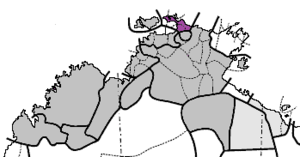Iwaidjan languages
| Iwaidjan | |
|---|---|
| Geographic distribution: | Cobourg Peninsula region, Northern Territory |
| Linguistic classification: |
|
| Subdivisions: | |
| Glottolog: | iwai1246[1] |
|
Iwaidjan languages (purple), among other non-Pama-Nyungan languages (grey) | |
|
Closeup. Amurdag is the southern section (tan), Wurrugu the tip of the peninsula (green), the rest Iwaidjic (purple). On the grey island just offshore is Marrgu, once thought to be Iwaidjan. | |
The Iwaidjan or Yiwaidjan languages are a small family of non-Pama–Nyungan Australian Aboriginal languages spoken in the Cobourg Peninsula region of Western Arnhem Land.
In 1997 Nicholas Evans proposed an Arnhem Land family that includes the Iwaidjan languages, though their inclusion is not accepted in Bowern (2011).[2]
The Iwaidjan languages
| Iwaidjan |
| ||||||||||||||||||||||||||||||||||||
| |
Garig and Ilgar are two almost identical dialects.[3] Manangkari may be a dialect of Maung.[4]
Dixon (2002) considers Warrkbi demonstrated, but Iwaidjic (Warrkbi-Maung) and Iwaidjan to be speculative. He predicts that working out the histories of the languages will be a "profound challenge", regardless of whether they are a genealogical family or a language area.
Marrgu and Wurrugu, previously lumped in with Iwaidjan, have little in common with it and may turn out to be a separate family.
Status
Iwaidja is spoken by about 150 people in the community of Minjilang on Croker Island,[5] alongside English, Kunwinjku and Maung. Maung is primarily spoken in the community of Warruwi on Goulburn Island, and it too has about 150 speakers.[5] Both languages are still being learnt by children.[5]
All the other Iwaidjan languages are close to extinction. In 1998, Amurdak had three remaining speakers, Garig and Ilgar three speakers between them.[5]
Phonology
The Iwaidjan languages have similar phoneme inventories. Exceptions are noted below the tables.
Vowels
| Front | Back | |
|---|---|---|
| High | i | u |
| Low | a | |
In addition to these, Maung also has /e/ and /o/, mostly in loanwords from Kunwinjku and Kunbarlang.[6]
Consonants
| Peripheral | Laminal | Apical | |||
|---|---|---|---|---|---|
| Bilabial | Velar | Palatal | Alveolar | Retroflex | |
| Plosive | p | k | c | t | ʈ |
| Nasal | m | ŋ | ɲ | n | ɳ |
| Approximant | w | p | j | ɻ | |
| Trill | ɲ | ||||
| Tap | ɽ | ||||
| Lateral approximant | ʎ | l | m | ||
| Lateral flap | ɺ | ɺ˞ [7] | |||
Maung lacks the two flapped laterals,[6] which are quite unusual among Australian languages. Also unusual is the velar approximant /ɰ/, which is an areal feature shared with Tiwi and Kunbarlang.[8]
Relationships with other languages
The vocabularies of all the Iwaidjan languages contain loanwords from Macassarese and Malay,[9] both Malayo-Polynesian languages from Indonesia. Iwaidja and Maung have also borrowed heavily from Kunwijku,[9] another Australian language of the Gunwingguan family.
While the Iwaidjan languages share a number of features with other non-Pama–Nyungan language families, it is uncertain which they are closest related to. Ross has proposed that they form part of an Arnhem Land family.
Notes
- ↑ Hammarström, Harald; Forkel, Robert; Haspelmath, Martin; Bank, Sebastian, eds. (2016). "Iwaidjan Proper". Glottolog 2.7. Jena: Max Planck Institute for the Science of Human History.
- ↑ Bowern, Claire. 2011. How Many Languages Were Spoken in Australia?
- ↑ Evans (1998): pp. 115, 144.
- ↑ Evans (1998): pp. 115–116.
- 1 2 3 4 Evans (1998): p. 115
- 1 2 Evans (1998): p. 118.
- ↑ There is no standard IPA symbol for a retroflex lateral flap. is sometimes seen, or ɭ̆.
- ↑ Evans (1998): p. 117.
- 1 2 Evans (1998): p. 116.
References
- Evans, Nicholas (1998). "Iwaidja mutation and its origins". In Anna Siewierska & Jae Jung Song. Case, Typology and Grammar: In honor of Barry J. Blake. Amsterdam/Philadelphia: John Benjamins Publishing Company. pp. 115–149.

.png)